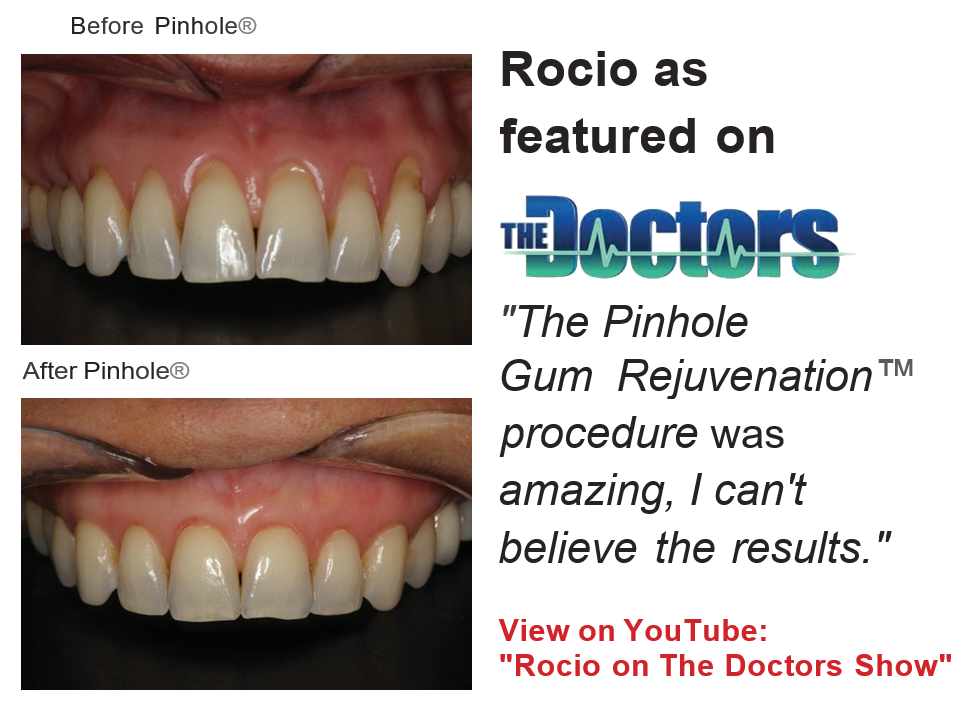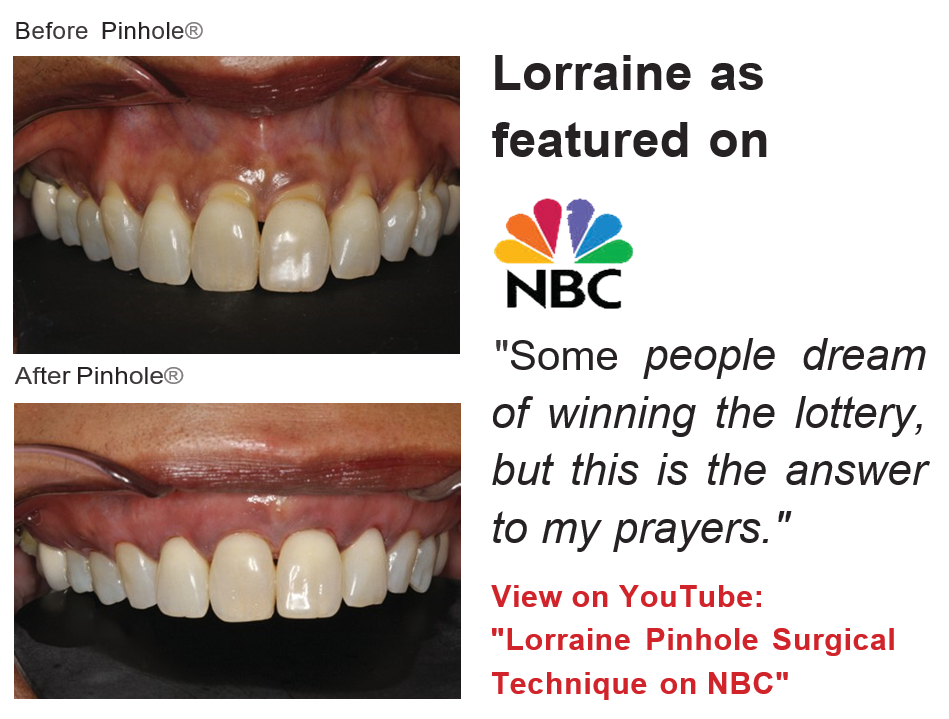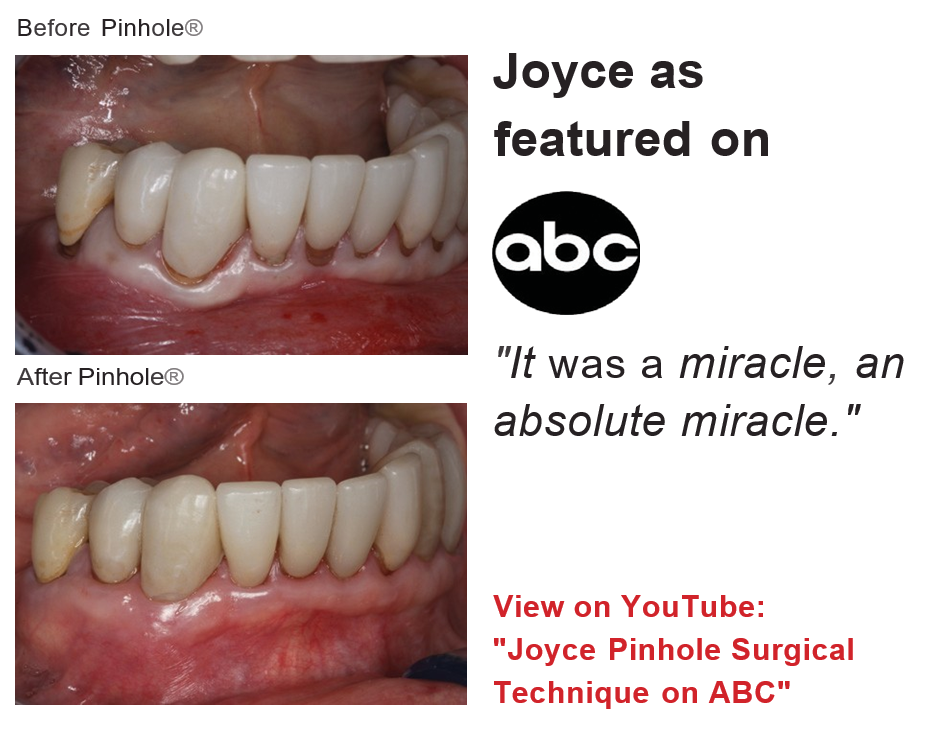Menu
The Chao Pinhole®Surgical Technique, also known as Pinhole Gum Rejuvenation™, was invented and patented by John Chao, D.D.S.
It is a scalpel-free, suture-free, graft-free, minimally invasive procedure for correcting gum recession and saving teeth. Through a small hole made by a needle, specially designed instruments are used to gently loosen the gum tissue and glide it over the receded part of the tooth. Since there is no cutting or stitching, patients can expect minimal post-operative symptoms (pain, swelling, and bleeding). Patients are pleasantly surprised by the instant cosmetic improvement. Most patients are able to resume light normal activities within 24-48 hours after treatment. (excluding working out and strenuous activities).
Gum recession is the process in which the margin of the gum tissue that protects the teeth wears away, or pulls back, exposing more of the tooth root. When gum recession occurs, “pockets”, or gaps form between the teeth and gum line, therefore, making it easy for disease-causing bacteria to build up and destroy teeth. If left untreated, the supporting tissue and bone structures of the teeth can be severely damaged and may ultimately result in tooth loss and even severe health consequences. Gum recession is a common dental problem and most people do not know that they have gum recession because it occurs gradually. The first sign of gum recession is usually tooth sensitivity or you may notice teeth that look longer than normal. Typically, a notch can be felt near the gum line. Do not ignore gum recession! Early detection and treatment are essential to maintaining overall health and saving teeth. If you think that your gums are receding, make an appointment immediately with a certified Pinhole®Surgical Technique dentist for an evaluation of your individual case.
These are bacterial gum infections that destroy gum tissue and the supporting bone that holds teeth in place. Gum disease is the main cause of gum recession and loss of teeth. Due to genetics, some people may be more susceptible to gum disease. In fact, studies show that 30% of the population may be predisposed to gum disease, regardless of how well they care for their teeth.




Gum recession refers to the loss of gum tissue along the gumline. This can occur as a result of
periodontal disease (gingivitis, periodontitis, advanced periodontitis), the natural aging process, or abrasive habits when it comes to brushing the teeth.
When gum recession occurs, the root structure of the tooth becomes exposed. This means that tooth decay and other problems can affect the teeth along the gumline and beneath it. Since healthy gums are essential for a healthy mouth, getting gum recession treated is important for lasting dental wellness.
The Chao Pinhole® Surgical Technique is a minimally invasive option for treating gum recession. Unlike traditional grafting techniques, PST is incision and suture-free. All of the tools and techniques used to perform the Chao Pinhole® Surgical Technique were created by Dr. John Chao, and who trained our doctor.
Traditional gum recession treatments involve the use of donor tissue or soft tissue grafts in order to rebuild the gumline. This soft tissue would be sutured in place and would join with existing gum tissue as it healed. While this traditional grafting treatment is effective, comparable results with better patient experience can be achieved through the Chao Pinhole® Surgical Technique.
During the Chao Pinhole® Surgical Technique, a needle is used to make a small hole in the patient’s existing gum tissue. Through this pinhole, special instruments are used to gently loosen the gum tissue. These tools help expand and slide the gumline to cover the exposed root structure. There are no grafts, no sutures, and no incisions needed with the Chao Pinhole® Surgical Technique. It simply involves the adjustment of the existing tissue.
The benefits of the Chao Pinhole® Surgical Technique are many:
The unique features of the Pinhole®Surgical Technique have aroused international interest on the part of the media. Over 240 TV stations around the world have featured this revolutionary, minimally invasive technique for treating a problem that is found in half of the U.S. population



Instrument: Patent No. US 8,007,278,B2 Method: Patent No. US 8,202,092,B2 Copyright 2015©